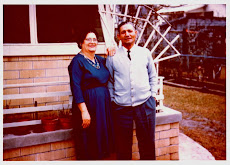If you had flown over Point Cadet back when it still had houses you would have noticed that most of the neighborhood cottages featured small, usually flat-topped, sheds in their back yards. Sheds were an indispensible part of Point life, especially if your family was part of the seafood industry. And back then, whose family wasn’t?
These sheds weren’t ornamental like the cute little “potter’s sheds” or other outbuildings often highlighted in Southern Living magazine.
Mostly home-built, largely unpainted with metal (rusty) roofs, sheds were storage units/spare bathrooms/ auxiliary kitchens. Many of them began existence as out houses in the days before indoor baths. They had creaky floors, cobwebby interiors and invariably smelled like old grease, saltwater, crab boil and mildew.
Most sheds had deep double-sinks for washing out shrimp nets, cast nets, crab nets. They were located next to the property’s fenceline so you could just spread the nets out along the fence to dry. The sides of sheds were also excellent places to grow the ubiquitous fig trees found in almost Point yard.
Like many sheds, the one at Nona and Grandpa’s house sported a rudimentary shower stall. After spending week or more on the boat handling stinky cargo with nothing more cleansing than a saltwater dip in the Gulf, Grandpa always visited the shed shower before coming inside the house to dispense hugs and kisses.
The grandchildren (most of whom did not live on the Point) found the shed shower extremely exotic -- especially the homemade shampoo with a real egg floating in it. We all liked to take showers out there -- partly because there was no showerhead in the inside bathroom, but mostly just because we could.
Perhaps, the shed’s most distinguishing feature was its old gas stove. Nona occasionally cooked dinner on it during the height the summer, but its real purpose was to fuel the seafood boils and fish fries that constituted summer entertaining on the Point.
For all the reams of newsprint and hours of debate that have been devoted to this subject, there’s really nothing complicated about a seafood boil. Cover seafood (shrimp or crabs) with water. Add lots of salt, peppercorns, whole heads of garlic, a couple of celery stalks, an onion cut in quarters, halved lemons and crab boil to taste. Boil it all until the seafood turns bright red. Drain and dump the seafood out on a picnic table covered with newspaper and dig in.
Today, people often like to add corn, potatoes and even sausage to their seafood boil. As tasty as this is, to my mind this seems more like a classic Low Country Frogmore Stew than something I remember from Point Cadet.
On the Point, there was only one permissible seasoning for a seafood boil, Zatarains crab boil. The only question was did you want the liquid kind out of a bottle, or the dry kind that comes in the little gauzy packets. Old Bay Seasoning, though delicious in the appropriate context, is an East Coast spice. It just didn’t – and never will -- belong in a Point Cadet seafood boil.
My Uncle Raymond, who was also a shrimper, liked his seafood spicy, spicy, spicy. My outstanding memory of his seafood boils is of the cayenne-spiked juice dribbling out of the shimp and crab shells and stinging the mosquito bites that always dotted my arms and legs. I was, am and always will be skeeter bait.
My grandfather didn’t like to overpower the delicate flavor of the seafood. When he was manning the stove, he went easy on the crab boil. This is also my preferred way of eating them.
Try it both ways, and judge for yourself.
Subscribe to:
Post Comments (Atom)


No comments:
Post a Comment